Highlights
- In October, we formalized a partnership with the American Anthropological Association (AAA). Through this partnership, AAA will encourage its members to participate in Wiki Education’s programs, increasing the availability of information about anthropology from a global perspective on Wikipedia.
- Classroom Program staff held their second round of Office Hours earlier this month. These sessions invite instructors to ask questions of program staff and each other about using Wikipedia in the classroom, and offer us a valuable opportunity to gauge the changing needs of our program participants.
- We announced a new Visiting Scholar this month; Paul Thomas will work with the University of Pennsylvania to develop Wikipedia articles related to Classics. He has already done some great work since becoming a Visiting Scholar, including bringing Liber physiognomiae up to Good Article status.
- Cassidy Villeneuve was hired this month as Wiki Education’s new full-time Communications Associate. Her role supports staff across departments and projects in general communication needs, as well as maintains the wikiedu.org blog.
Programs
Educational Partnerships
We formalized a partnership with our newest academic association, the American Anthropological Association (AAA). AAA is an organization promoting the development and dissemination of anthropological knowledge. Through this partnership and Wikipedia initiative, AAA will encourage its members to participate in Wiki Education’s programs, increasing the availability of information about anthropology from a global perspective on Wikipedia.
Outreach Manager Samantha Weald ran two online workshops for instructors interested in learning more about Wiki Education and teaching with Wikipedia. The first webinar was with a graduate level course at George Mason University, where students were interested in “Higher Education in the Digital Age” and how Wiki Education’s work promotes open access, open educational resource-enabled pedagogy, and digital literacy. The second webinar was for a group of instructors at Louisiana State University interested in implementing these assignments in their research and writing courses.
Classroom Program
Status of the Classroom Program for Fall 2017 in numbers, as of October 31:
- 306 Wiki Education-supported courses were in progress (169, or 55%, were led by returning instructors)
- 5,946 student editors were enrolled
- 58% were up-to-date with the student training
- Students edited 3,100 articles, created 92 new entries, and added 1.05 million words.
It’s the middle of the term which means that our students are well underway with their Wikipedia assignments. They’ve chosen their topics and are beginning to draft their contributions. With more than 5,500 students enrolled on the Dashboard, the Classroom Program is busy monitoring their work and responding to questions.
As part of our efforts to improve the quality of our support to a growing number of courses doing Wikipedia assignments, we held our second round of Wiki Education Office Hours earlier this month. During these sessions, instructors in our program have the chance to meet face-to-face with Wiki Education staff, interact with other instructors using Wikipedia in their classrooms, and ask critical questions about their Wikipedia assignments. Questions range from concerns over privacy on Wikipedia to the logistics of keeping track of student contributions. These sessions are incredibly valuable to us, and we use them to gauge the changing needs of our program participants.
If one word could define Fall 2017, it’s quality. With several terms of experience and growth behind us, we’ve focused our efforts this term on ensuring that we provide the most effective support to our program participants while refining processes to make sure that our student contributions to Wikipedia are of the highest quality. While the Fall term is just gearing up for our students, we’re already preparing for Spring 2018. We’ll continue to apply our learnings as we transition to the next term.
In 2015, the United States Supreme Court issued a judgement on Obergefell v. Hodges, stating that state bans on same-sex marriage was unconstitutional. Many saw one of their fondest desires granted — the ability to legally marry the person they loved. This freedom is, however, not recognized by all Native American tribes, making it necessary for people such as Heather Purser to fight for tribal recognition. Purser knew from an early age that she was a lesbian but did not come out until her teens, aware that not everyone in her family and community would be supportive of her sexuality. After coming out, Purser was subjected to physical and emotional attacks against her person, however she didn’t allow this to discourage her and in 2009, began petitioning her tribal leaders to recognize same-sex marriage. Approximately two years later her one-woman campaign ended with about 300 of her fellow tribes members voting in favor of recognizing same-sex marriage. If not for a student in California State University educator Karyl E. Ketchum’s Gender and Technoculture class, this woman’s courageous efforts might not have been recorded on Wikipedia for months, years, or possibly not ever, which would have left a hole in Wikipedia’s LGBT coverage.
There are many amazing people in this world — all of us likely have several people that would fit this description, both in our personal lives and from those we’ve discovered through the media or education. Janice Forsyth is one person who merits being called “amazing”, as she has earned multiple degrees from Western University, began working as an educator while earning a PhD, wrote multiple publications and technical reports, and also competed in Western University’s badminton, cross country, and track & field teams while a student. She’s also the University’s Director of the First Nations Studies Program and has earned awards for both her time as an athlete as well as her academic and scholarly work. Forsyth’s research leans towards Aboriginal and indigenous physical culture and its history, interests that were undoubtedly inspired by her ties to the Fisher River Cree and Peguis First Nation in Manitoba, Canada, via her maternal family. Only a portion of Wikipedia’s editors actively create articles on academics, which makes this contribution from Victoria Paraschak’s Sport and Aboriginal Peoples in Canada students at the University of Windsor that much more important. If not for them, Forsyth’s impressive accomplishments may have continued to go unrecorded for an indeterminate amount of time — just as with Purser’s article.
Animals form aggregations for a wide variety of reasons, and sometimes those aggregations can have unexpected effects. When pods of Norwegian orcas encounter a school of herring, the orcas will split off a portion of a school and herd it into a tight, ball-like formation from which members of the pod will feed. This behavior is known as carousel feeding. Students in David Wilson’s Animal Behaviour class expanded a short stub on this topic into a fairly substantial article that looks at the herding and feeding behavior of the orcas, and the ecological impact of this practice.
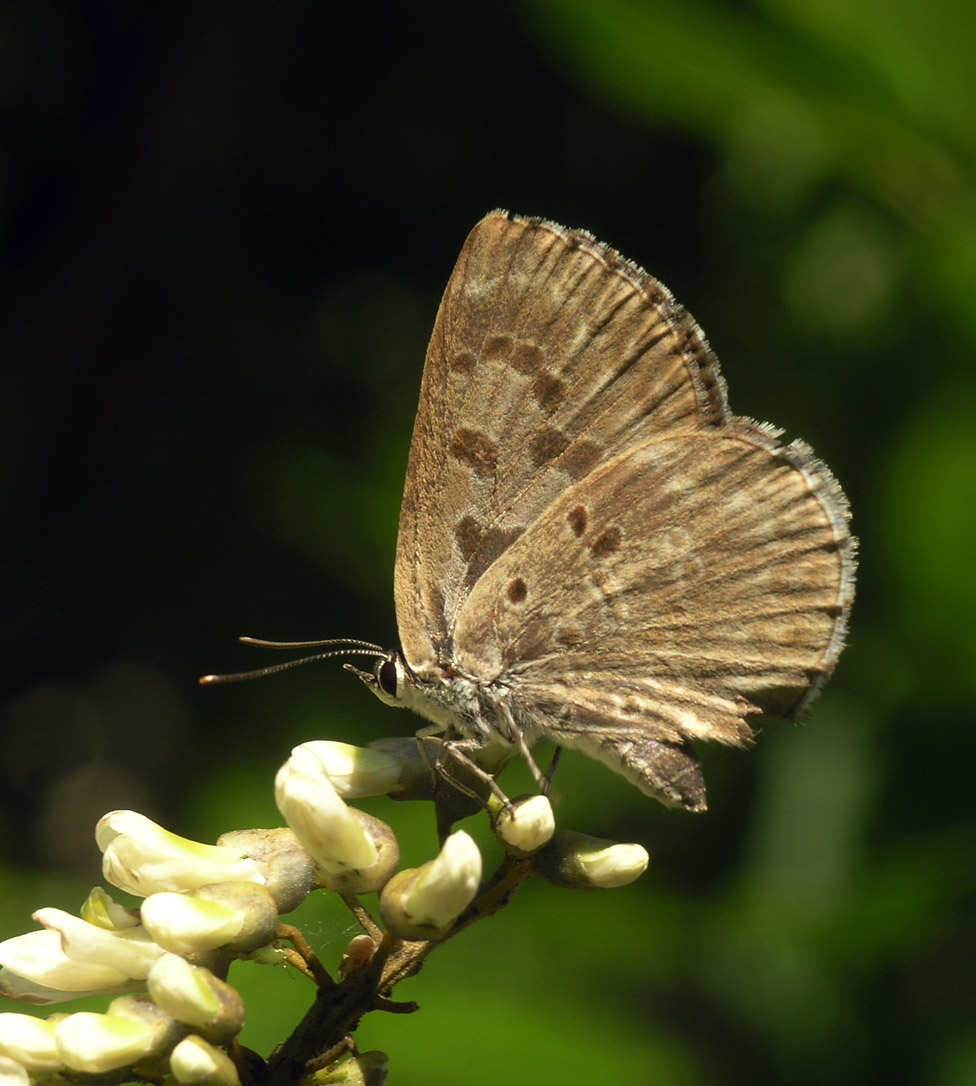
Image: File:Niphanda fusca9.jpg, Oleg Kosterin, via Wikimedia Commons.
The bogong moth is an Australian moth that forms aggregations for another purpose — during the heat of summer, they migrate to mountain caves where millions of them gather, in densities as high as 17,000 individuals per square meter. Such a dense gathering doesn’t simply concentrate moths—it also concentrates the elements in their bodies that they have absorbed while feeding. In 2001, runoff from these caves, enriched as it was in moth–transported arsenic, proved toxic to native grasses. The bogong moth article was one of the many articles about butterflies and moths that were expanded by students in Joan Strassmann’s Behavioral Ecology class. Working from little more than a stub, a student in the class expanded Wikipedia’s coverage of this moth into a fairly comprehensive article that discusses the social behavior, diet, distribution, migration and life cycle, among other things.
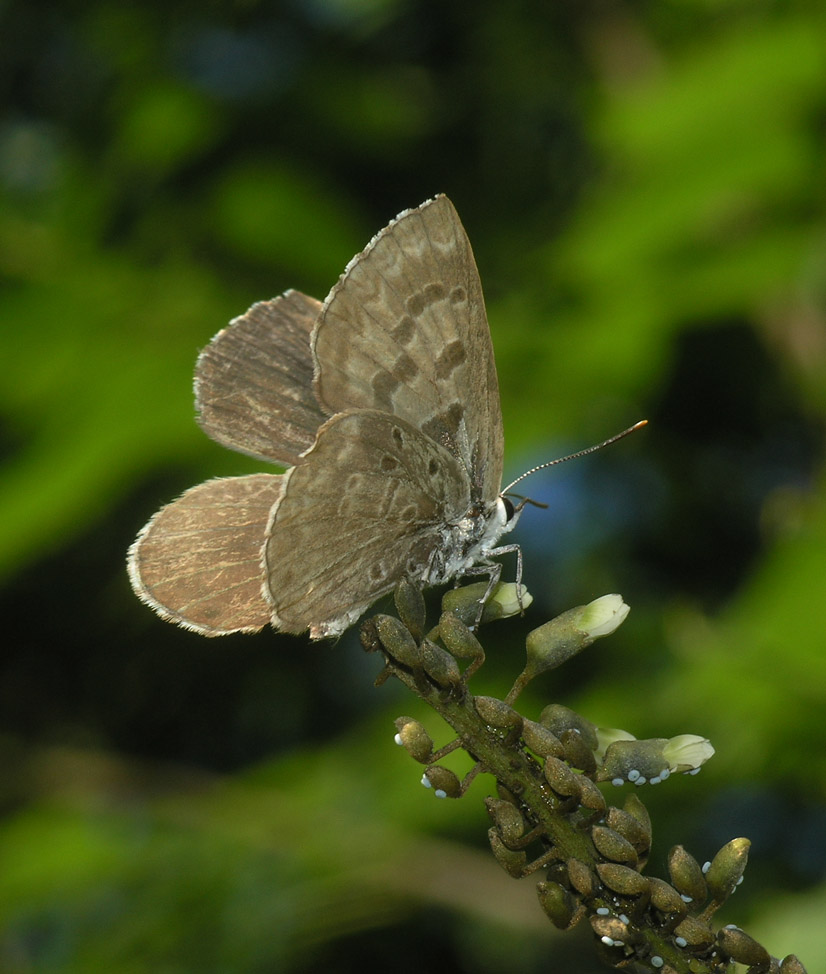
Image: File:Niphanda fusca7.jpg, Oleg Kosterin, via Wikimedia Commons.
Butterflies are usually thought of as delicate and beautiful. The marsh fritillary, Polygonia c-album, Niphanda fusca, and Gonepteryx rhamni all fit this picture, but many other lepidopterans have an entirely less benign reputation. The eastern spruce budworm, Choristoneura fumiferana, is one of the most destructive native insect pests in North America; outbreaks are capable of defoliating millions of hectares of forest. The codling moth is a major pest of apples and pears. Spodoptera litura, commonly known as the tobacco cutworm or cotton leafworm, is a pest of a wide variety of crops, including (as the common names suggest) tobacco and cotton, as does Heliothis virescens, commonly known as the tobacco budworm. The larvae of the cabbage looper attack cruciferous vegetables, while those of the almond moth, on the other hand, feed on dried fruit, grains, and nuts. These articles are among the very many articles that were substantially expanded by students in the Behavioral Ecology class.
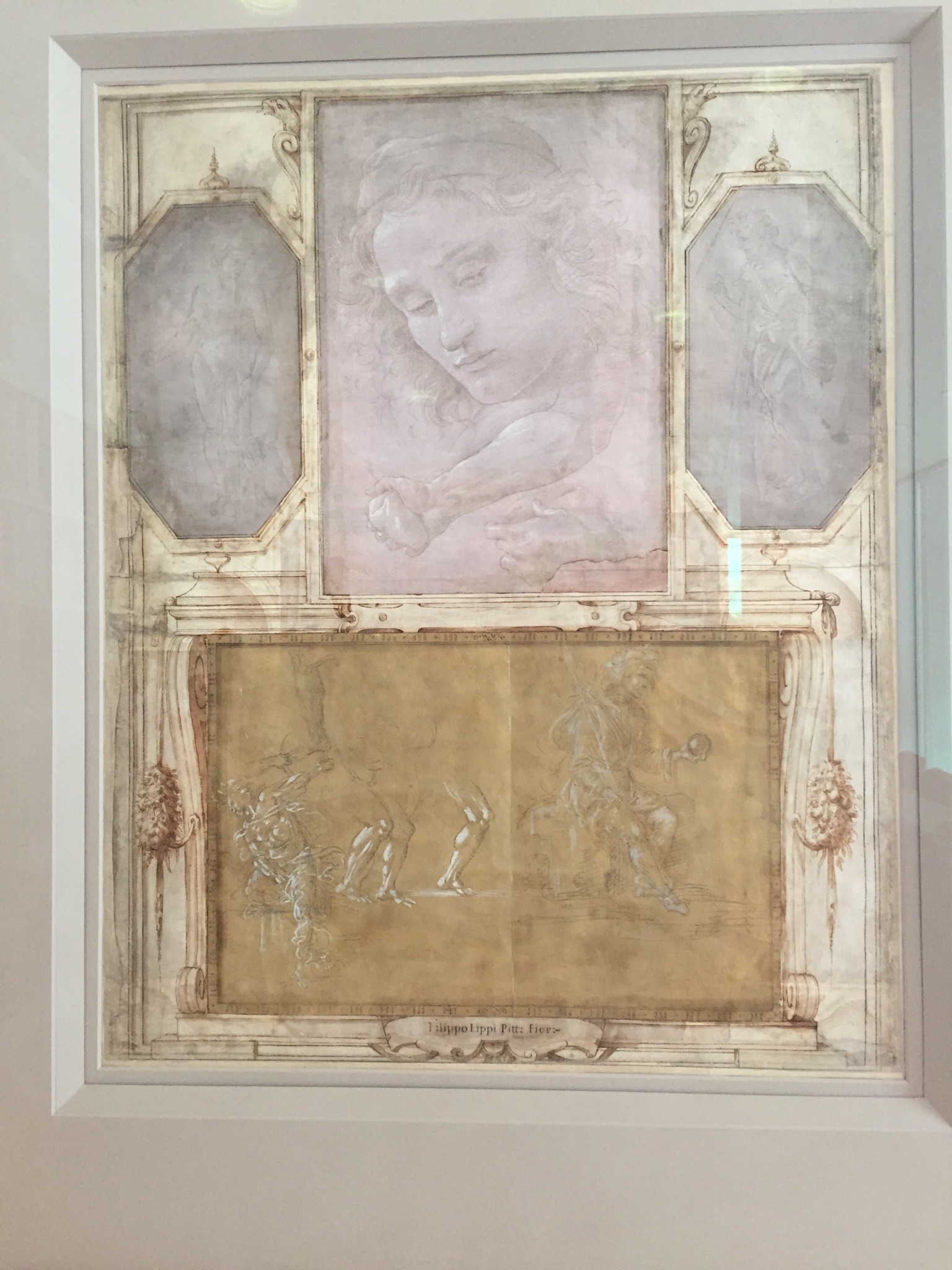
Image: File:Page from “Libro de’ Disegni”- 1.jpg, by Giorgio Vasari, public domain, via Wikimedia Commons.

Image: File:Harmonia macrocosmi cum microcosmi.jpg, by Tobias Schutz, public domain, via Wikimedia Commons.
Students in Alison Marshall’s class, The Scientress, have been working to expand articles on female scientists. In October, students created new articles on Verena Tunnicliffe, a Canadian marine biologist known for her work on hydrothermal vents, and Patricia Woolley, an Australian zoologist who works on dasyurid marsupials. Several students in Sara Galletti’s Art in Renaissance Italy class uploaded excellent photographs. One student uploaded an artwork that was created by Tobias Schutz in 1654, while another added a photograph they took of a Giorgio Vasari drawing at the National Gallery of Art.
Two other students also uploaded images they took at the National Gallery of Art, which show a deep appreciation of the building’s architecture — itself a lovely example of creativity.
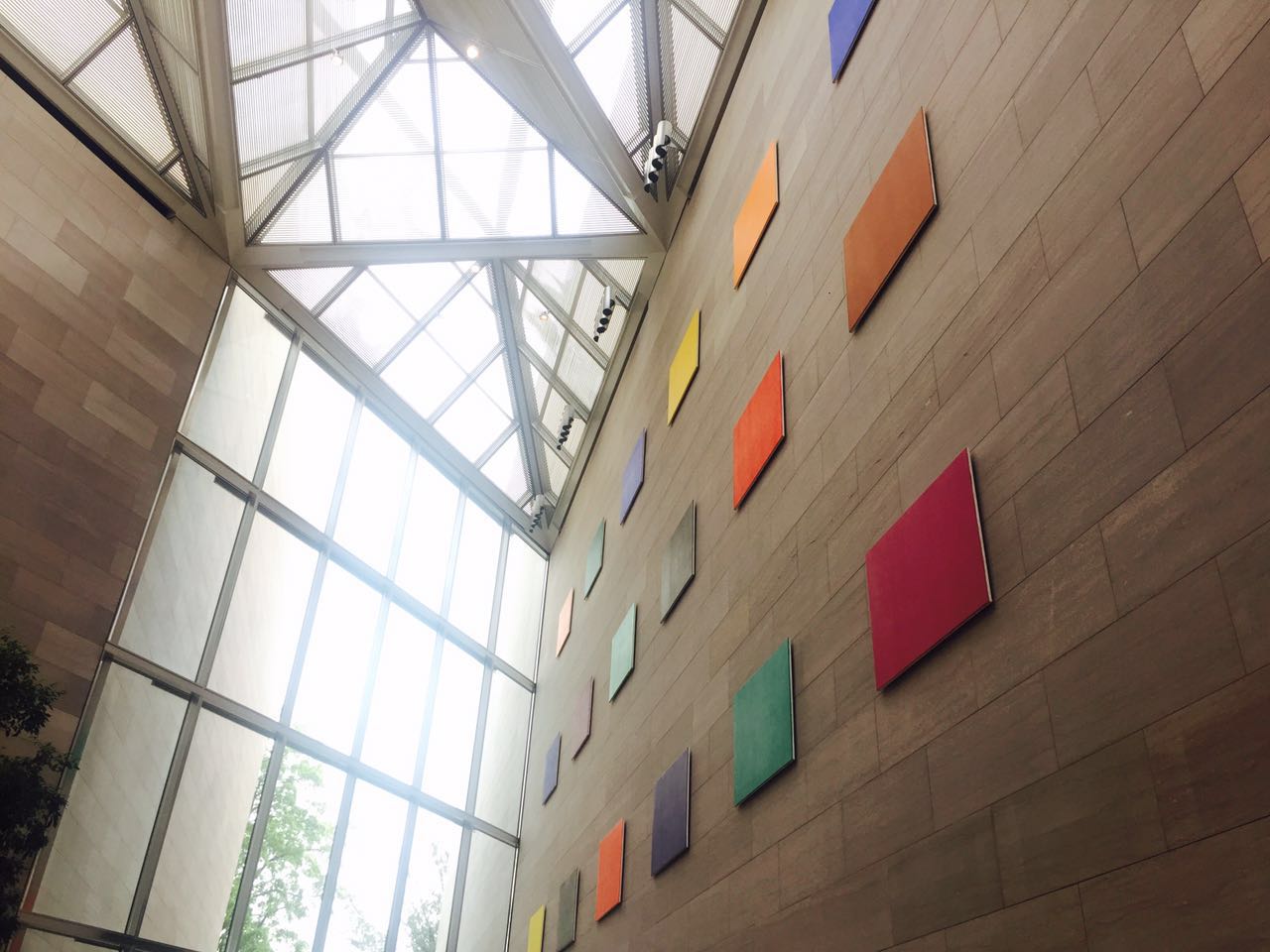
Image: File:National Gallery East Building Lobby.pic.jpg, by Atsushi Hu, CC BY-SA 4.0, via Wikimedia Commons.
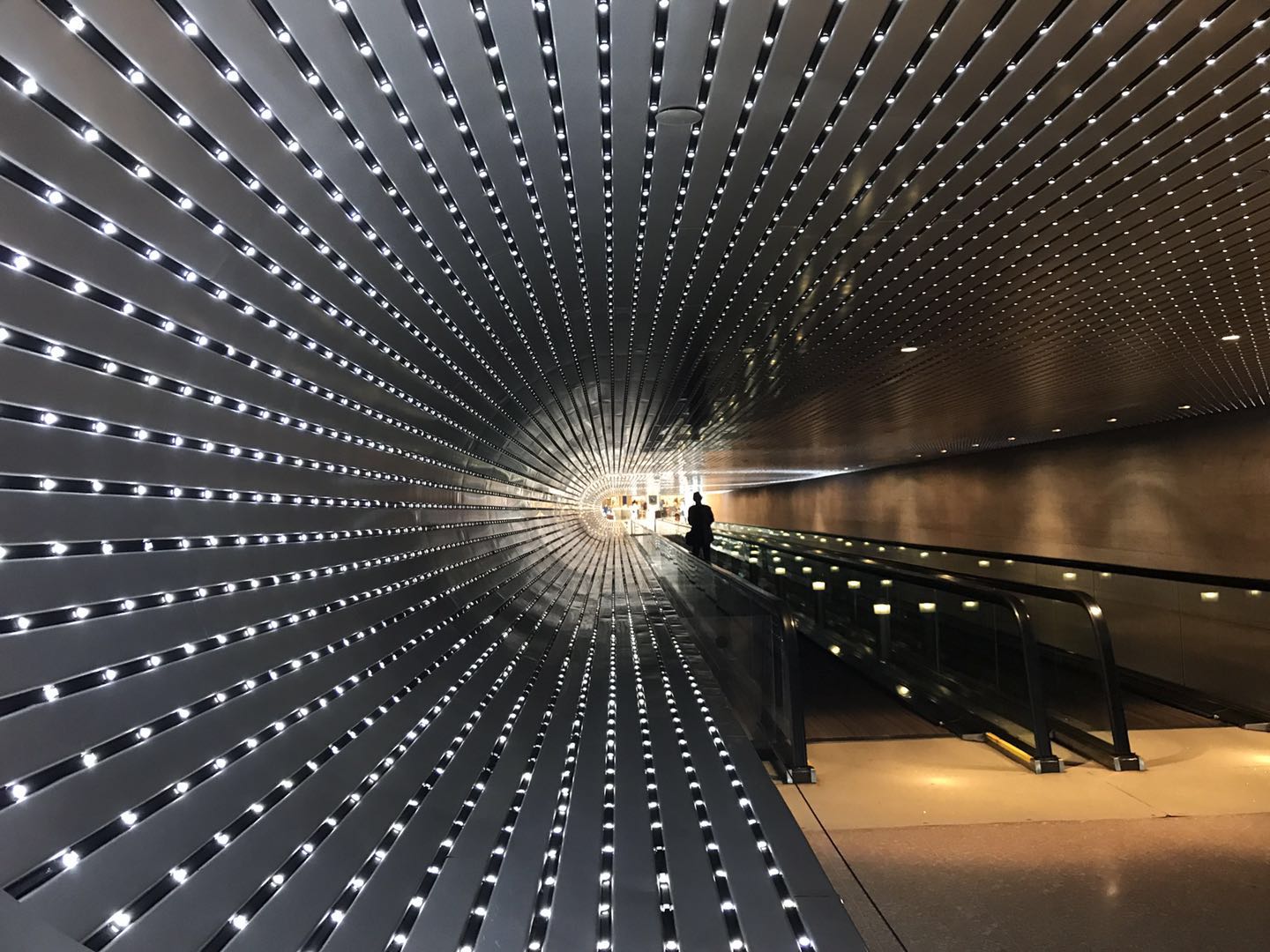
Image: File:Walkway to West Building and Cascade Cafe.jpg, by Evelyn y, CC BY-SA 4.0, via Wikimedia Commons.
Community Engagement
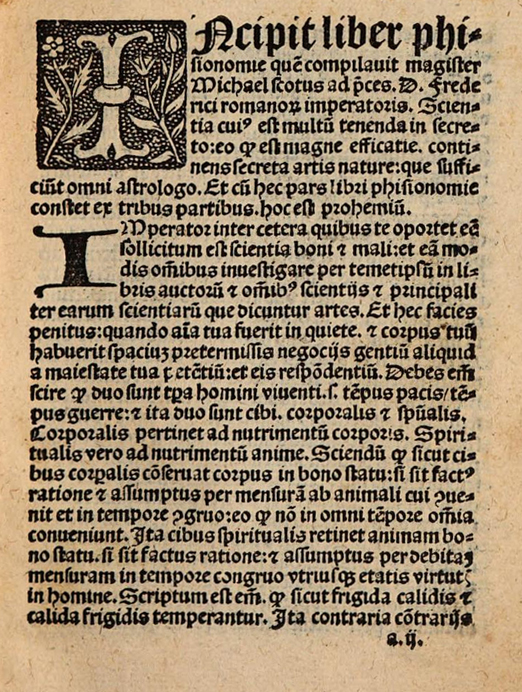
Image: File:Liber Physiognomiae Michael Scot.jpg, by Jean Petit (1505, original),
Gen. Quon (2016, touch-ups), public domain, via Wikimedia Commons.
Community Engagement Manager Ryan McGrady began the month announcing a new Visiting Scholar at the University of Pennsylvania, Paul Thomas. Editing as User:Gen. Quon, Paul is a prolific Wikipedian who has written more than 250 Good Articles, but he did not have access to key scholarship in one of his major areas of interest: Classics. We were excited to be able to connect him with Penn’s vast library resources and its Department of Classical Studies, which has provided undergraduate and graduate programs for more than 200 years. He has already written some impressive articles since becoming a Visiting Scholar. This month, he brought the article about the Liber physiognomiae, a book written in the 13th century about physiognomy, the evaluation of a person’s personality based on their outward appearance, up to Good Article status.
Other Visiting Scholars were busy this month, as well. Deep Carbon Observatory Visiting Scholar Andrew Newell had two articles appear in the Did You Know section of Wikipedia’s Main Page, extraterrestrial diamonds and organic mineral:

Image: SpaceNanoDiamonds.jpg, by NASA/JPL-Caltech, public domain, via Wikimedia Commons.
[Did You Know] … that carbon-carrying minerals are known as organic minerals, except for some that were considered inorganic before 1828?
[Did You Know] … that extraterrestrial diamonds in meteorites preserve their history from before the Solar System formed?
Two high-visibility articles improved by George Mason University Visiting Scholar Gary Greenbaum were promoted to Featured Article. The first was Spiro Agnew, the 39th Vice President of the United States under Richard Nixon. The second on Casey Stengel, a professional baseball player turned baseball manager who led the Yankees to 7 world championships.
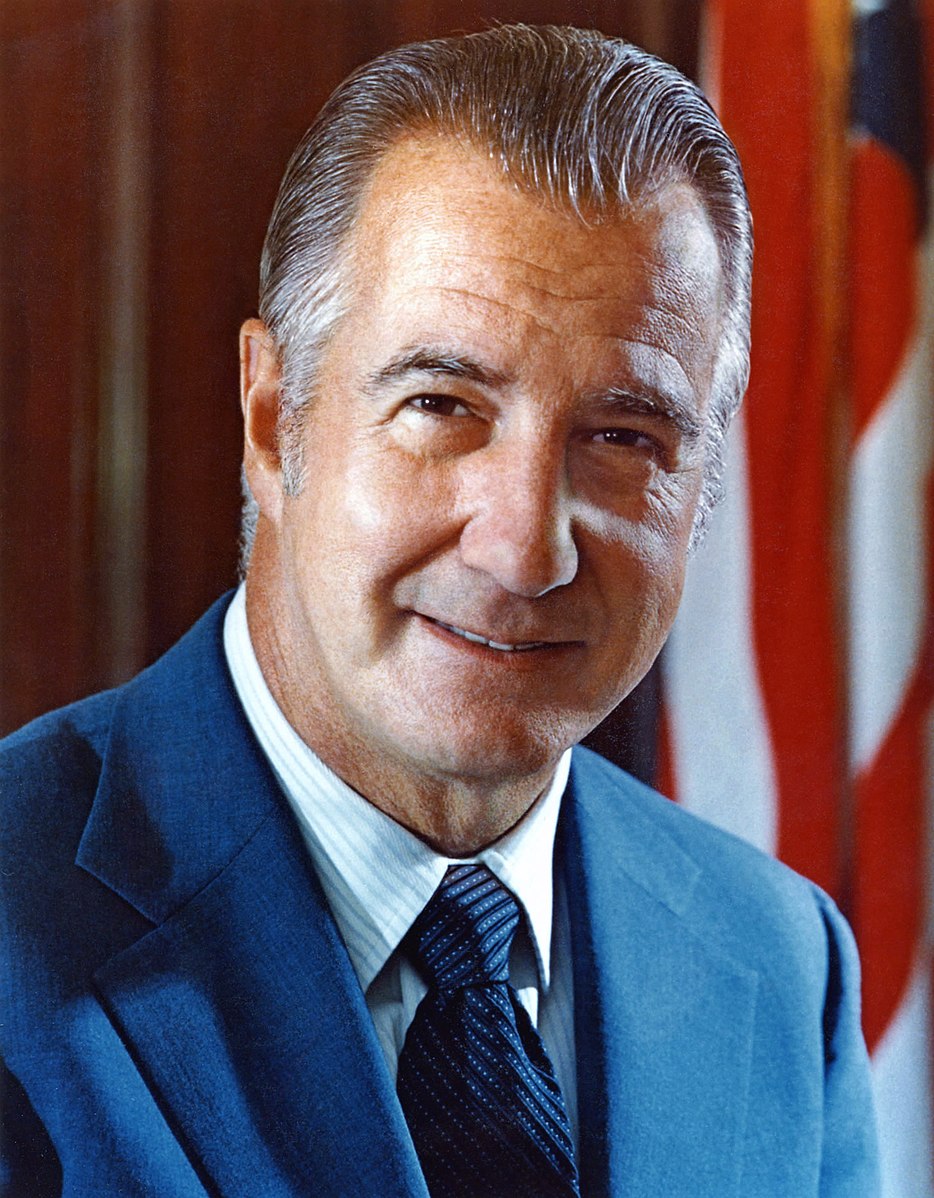
Image: Spiro Agnew.jpg, public domain, via Wikimedia Commons.
Rosie Stephenson-Goodknight, Visiting Scholar at Northeastern University, continued her run of creating great new articles about women writers, including physician Lucy M. Hall, who wrote about health topics for magazines and periodicals, and Julia C. R. Dorr, an American author of poetry and prose who published her work in literary publications as well as in many of her own books.
Eryk Salvaggio at Brown University created an article about the Canales investigation, a congressional hearing in 1919 concerning criminal conduct by the Texas Rangers. The article also appeared as a Did You Know:
[Did You Know] … that the Canales investigation heard 80 witnesses describing murders, kidnappings, and other crimes committed by the Texas Rangers in the early 20th century?
Ryan spent time this month working with Educational Partnerships Manager Jami Mathewson and Communications Associate Cassidy Villeneuve to develop communications materials and strategies for our 2018 Wikipedia Fellows pilot, and coordinating with current and prospective Visiting Scholars and sponsors at varying stages of the onboarding process.
Program Support
Communications
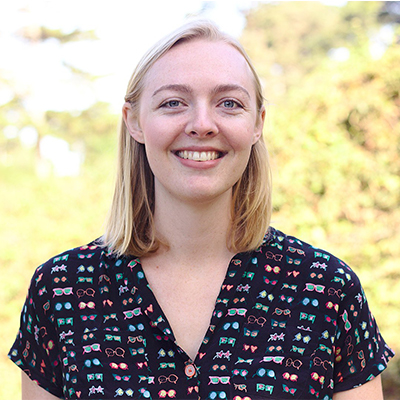
In October, Cassidy Villeneuve was hired as Communications Associate. Her role will support staff across departments and projects in general communication needs.
So far, that has included working with Ryan and Jami in preparing communications for Wiki Education’s upcoming pilot, Wikipedia Fellows. Cassidy worked with Samantha and Jami to develop an updated landing page for new instructors as well. Cassidy has also been working on updating text on our support site, ask.wikiedu.org, to more efficiently address issues instructors and students often encounter.
And in further efforts to improve our training resources, Cassidy worked with Wikipedia Content Expert Ian Ramjohn in developing a new training module for students to find appropriate Wikipedia articles that need improvement.
Blog posts:
- Roundup: Hearing Conservation (October 2)
- Student editors and Nobel Prizes (October 3)
- Presentation at Howard University (October 3)
- Welcome, Özge! (October 4)
- Gen. Quon is Wikipedia Visiting Scholar at the University of Pennsylvania (October 4)
- American Studies Association to improve Wikipedia’s coverage of U.S. culture and history from multiple perspectives (October 5)
- Welcome, Cassidy! (October 6)
- Roundup: Closing the gender gap in cinema on Wikipedia (October 9)
- The Web As She Is Spoke (October 10)
- Wikipedia, Webinars, and Wiki Education (October 11)
- The Written Word podcast features Wikipedia assignments (October 13)
- The Right Fit (October 16)
- Domestic Violence Awareness Month and Feminist Economics on Wikipedia (October 17)
- Roundup: Building Online Communities (October 23)
- Wiki Education partners with National Communication Association (October 26)
- Finding agency and building confidence through a Wikipedia assignment (October 27)
- Roundup: Classics in Linguistics (October 31)
Digital Infrastructure
In October, Product Manager Sage Ross focused on infrastructure improvements and a wave of upgrades to the Dashboard’s student training modules and course creation features.
Our websites — wikiedu.org, the Dashboard, ask.wikiedu.org, and several others — have now switched over to free “Let’s Encrypt” certificates, with improved HTTPS behavior to protect the data of all our visitors. Our key infrastructure has also been updated to the latest stable version of Debian GNU/Linux, which will help keep our servers secure. In the process of performing these upgrades, we also discovered and subsequently fixed a set of critical bugs related to the Dashboard’s automated edit features.
Refreshes of the most important student training modules went live in mid-October, and feedback from students so far has been very positive. Our growing collection of subject-specific Wikipedia editing handouts has also been integrated into the assignment wizard, letting instructors select which topics are relevant and include them automatically in the assignment timeline. Other recent improvements include more comprehensive monitoring of Wikipedia’s deletion processes, reminders for newly registered users to set an email on their Wikipedia account (so that they can reset their password if it gets lost), and more data transferring automatically from the Dashboard to Salesforce to reduce the amount of manual data entry required for new courses.
Data analysis
In October, Jami spent the month working with a pro-bono data scientist to do a deep dive into our documented data and find interesting trends about our day-to-day work. Here are a few of our findings:
- Consistently since we started Wiki Education in Fall 2013, 44.5% of the new instructors joining the Classroom Program return to teach again within the academic year. This is exciting because we’ve spent those years increasing the number of students and instructors we support, even though we’ve had approximately the same number of staff members supporting the Classroom Program. One of our priorities is to make the Classroom Program more efficient, scaling up the impact to Wikipedia while decreasing the cost per student. To see that the same number of instructors have a good experience and choose to incorporate Wikipedia into another course shows our success in the attempts to scale.
- We investigated the efficacy of various outreach forums we use to recruit new instructors into the Classroom Program, and found that conferences are the most reliable way to produce active courses. When those conferences are related to one of our educational partners, they’re even more effective. This confirms we should continue our current strategy of recruiting potential program participants at partners’ conferences. The academic associations’ support of our work is meaningful, and it’s effective to find instructors where they already are: academic conferences.
- One of the most useful findings is that our limited timeframe (only going back 4 years) does not allow us to find many statistically significant trends. Importantly, we have now confirmed that while we’ll continue to track data we believe is important to the way we run our programs, we do not need to hire a full-time data analyst in the near future.
Finance & Administration/Fundraising
Finance & Administration
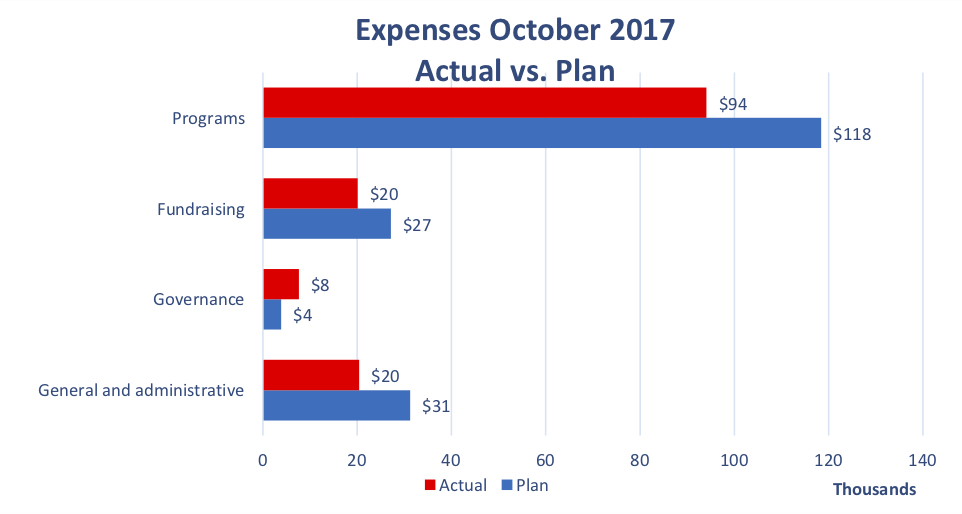
For the month of October, expenses were $142,286 versus the approved budget of $180,322. The $38k variance can be attributed to some staffing vacancies ($12k) and less than anticipated spending on professional services ($13k), and travel ($13k).
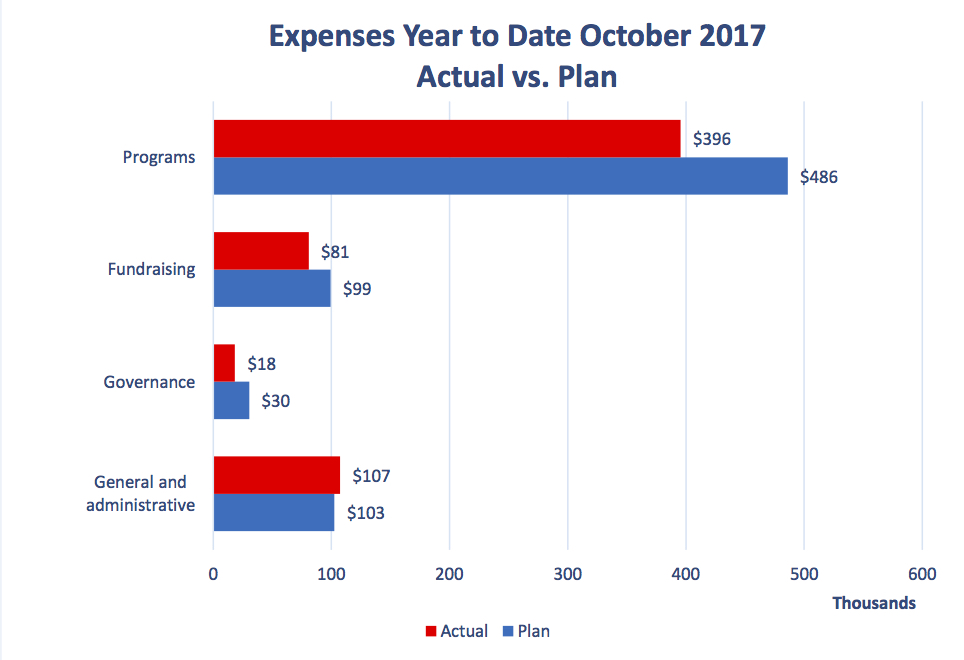
Our year-to-date expenses of $602,207 are also less than our budgeted expenses of $718,080 by $115,873. Areas where our spending was significantly under budget include staffing ($29k), professional services ($42k), travel ($27k), and general operating expenses ($17k).
Fundraising
In October, TJ Bliss, Director of Development and Strategy, continued to cultivate relationships with funders who we felt might be interested in Wiki Education because our work on the Future of Facts, Guided Editing, and Sustaining Science initiatives. Several funders have expressed interest in funding Wiki Education as a means of improving the accuracy and scope of content on Wikipedia in key subject areas like science and public policy. No proposals were requested and no new grants were received during the month of October.
We submitted a final grant report for the Simple Annual Plan Grant we received from the Wikimedia Foundation. The grant, which covered some expenses from May 1, 2017 to September 30, 2017, enabled us to wrap up our student learning outcomes project, finish up the Classroom Program’s spring term, and create a plan of action for our Future of Facts campaign. We thank the Wikimedia Foundation, WMF staff, and the Simple APG committee for their support during the grant process.
Office of the ED
Current priorities:
- Summarizing the results of the strategic planning meeting prior to the next in-person meeting in January
- Re-aligning internal processes after restructuring finance & administration
- Finalizing the audit and tax return for last fiscal year
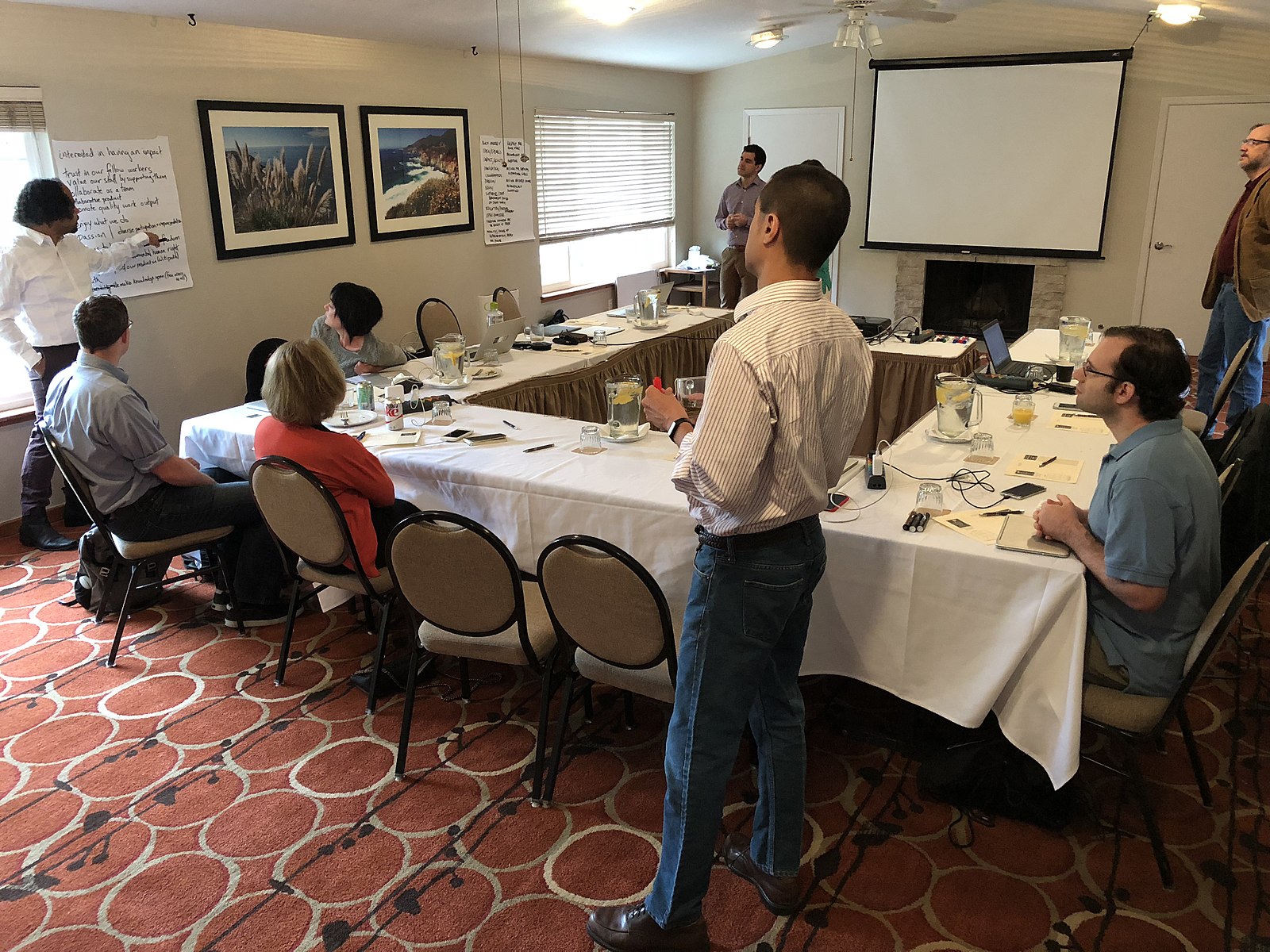
In October, board and senior leadership met in Half Moon Bay for a two-day, in-person strategic planning kick-off meeting. In the weeks leading toward the meeting, a strategy taskforce consisting of three board and two staff members had collected comprehensive input from both the board and staff on (1) forces and trends in our external environment that will define our work in the upcoming years, (2) our organization’s own strengths and weaknesses, and (3) our fundamental beliefs and values. This analysis served as the starting point for two days of intense deliberations about Wiki Education’s future direction. In a joint effort and based on the analysis, board and senior leadership developed a shared understanding of where to take the organization over the next three years. The results of this in-person meeting will be documented by staff in a high-level summary. This summary will serve as the foundation for the final strategy document and is intended to be confirmed by the board in its January meeting.
* * *
